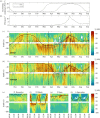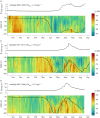A marine zooplankton community vertically structured by light across diel to interannual timescales
- PMID: 33622076
- PMCID: PMC8086989
- DOI: 10.1098/rsbl.2020.0810
A marine zooplankton community vertically structured by light across diel to interannual timescales
Abstract
The predation risk of many aquatic taxa is dominated by visually searching predators, commonly a function of ambient light. Several studies propose that changes in visual predation will become a major climate-change impact on polar marine ecosystems. The High Arctic experiences extreme seasonality in the light environment, from 24 h light to 24 h darkness, and therefore provides a natural laboratory for studying light and predation risk over diel to seasonal timescales. Here, we show that zooplankton (observed using acoustics) in an Arctic fjord position themselves vertically in relation to light. A single isolume (depth-varying line of constant light intensity, the value of which is set at the lower limit of photobehaviour reponses of Calanus spp. and krill) forms a ceiling on zooplankton distribution. The vertical distribution is structured by light across timescales, from the deepening of zooplankton populations at midday as the sun rises in spring, to the depth to which zooplankton ascend to feed during diel vertical migration. These results suggest that zooplankton might already follow a foraging strategy that will keep visual predation risk roughly constant under changing light conditions, such as those caused by the reduction of sea ice, but likely with energetic costs such as lost feeding opportunities as a result of altered habitat use.
Keywords: Arctic; isolume; migration; predation; zooplankton.
Figures


Similar articles
-
Photophysiological cycles in Arctic krill are entrained by weak midday twilight during the Polar Night.PLoS Biol. 2021 Oct 19;19(10):e3001413. doi: 10.1371/journal.pbio.3001413. eCollection 2021 Oct. PLoS Biol. 2021. PMID: 34665816 Free PMC article.
-
Shine a light: Under-ice light and its ecological implications in a changing Arctic Ocean.Ambio. 2022 Feb;51(2):307-317. doi: 10.1007/s13280-021-01662-3. Epub 2021 Nov 25. Ambio. 2022. PMID: 34822117 Free PMC article. Review.
-
Two hundred years of zooplankton vertical migration research.Biol Rev Camb Philos Soc. 2021 Aug;96(4):1547-1589. doi: 10.1111/brv.12715. Epub 2021 May 4. Biol Rev Camb Philos Soc. 2021. PMID: 33942990
-
Seasonal and diel variations in the vertical distribution, composition, abundance and biomass of zooplankton in a deep Chilean Patagonian Fjord.PeerJ. 2022 Jan 25;10:e12823. doi: 10.7717/peerj.12823. eCollection 2022. PeerJ. 2022. PMID: 35127292 Free PMC article.
-
Climate change and Southern Ocean ecosystems I: how changes in physical habitats directly affect marine biota.Glob Chang Biol. 2014 Oct;20(10):3004-25. doi: 10.1111/gcb.12623. Epub 2014 Jun 30. Glob Chang Biol. 2014. PMID: 24802817 Review.
Cited by
-
A new Activity Monitor for Aquatic Zooplankter (AMAZE) allows the recording of swimming activity in wild-caught Antarctic krill (Euphausia superba).Sci Rep. 2024 Jul 23;14(1):16963. doi: 10.1038/s41598-024-67999-3. Sci Rep. 2024. PMID: 39043920 Free PMC article.
-
Photophysiological cycles in Arctic krill are entrained by weak midday twilight during the Polar Night.PLoS Biol. 2021 Oct 19;19(10):e3001413. doi: 10.1371/journal.pbio.3001413. eCollection 2021 Oct. PLoS Biol. 2021. PMID: 34665816 Free PMC article.
-
Cloud shadows drive vertical migrations of deep-dwelling marine life.Proc Natl Acad Sci U S A. 2021 Aug 10;118(32):e2022977118. doi: 10.1073/pnas.2022977118. Proc Natl Acad Sci U S A. 2021. PMID: 34349017 Free PMC article.
-
Animal behavior is central in shaping the realized diel light niche.Commun Biol. 2022 Jun 8;5(1):562. doi: 10.1038/s42003-022-03472-z. Commun Biol. 2022. PMID: 35676530 Free PMC article.
-
Shine a light: Under-ice light and its ecological implications in a changing Arctic Ocean.Ambio. 2022 Feb;51(2):307-317. doi: 10.1007/s13280-021-01662-3. Epub 2021 Nov 25. Ambio. 2022. PMID: 34822117 Free PMC article. Review.
References
-
- Forward RBJ Jr. 1988. Diel vertical migration: zooplankton photobiology and behaviour. Oceanogr. Mar. Biol. Annu. Rev. 26, 361-393.
-
- Cohen JH, Forward RB. 2009. Zooplankton diel vertical migration - a review of proximate control. Oceanogr. Mar. Biol. Annu. Rev. 47, 77-110.
-
- Houston AI, McNamara JM, Hutchinson JMC. 1993. General results concerning the trade-off between gaining energy and avoiding predation. Phil. Trans. R. Soc. Lond. B 341, 375-397. ( 10.1098/rstb.1993.0123) - DOI
-
- Titelman J, Fiksen Ø. 2004. Ontogenetic vertical distribution patterns in small copepods : field observations and model predictions. Mar. Ecol. Prog. Ser. 284, 49-63. ( 10.3354/meps284049) - DOI
Publication types
MeSH terms
LinkOut - more resources
Full Text Sources
Other Literature Sources
Miscellaneous

